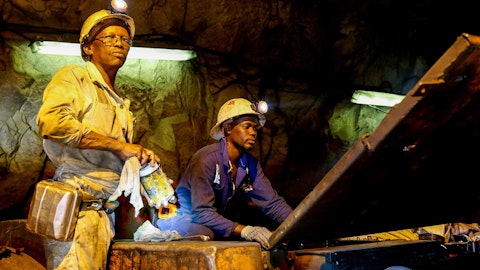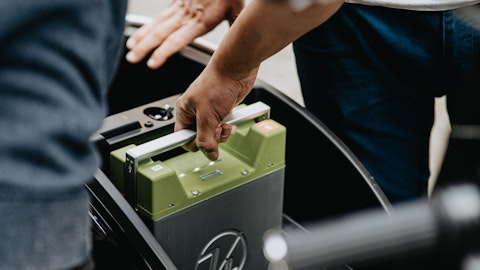Jugal Vijayvargiya: Yes. As you know, Mike, we’ve all been waiting for this inventory correction to start to slow down so that the rates — build rates can start to pick back up. But unfortunately, the inventory correction and our customers has taken a little bit longer than I think they had all estimated. That inventory correction, of course, or the slowdown of that, translates into slower orders for us. Our expectation was that maybe towards the end of Q3, we would start to see a little bit of recovery. I think that expectation has now shifted to Q4. We’re starting to see, as we’re listening to some of the earnings calls, from our customers, some small positive incremental benefits that they’re highlighting. We’re also starting to hear some things from our customers directly.
Some of our orders, so depending on the semiconductor types, order rates are starting to see a little bit of an uptick maybe for Q4. So, I would say it seems like Q3 is the low point, and Q4 would be a small incremental uptick for us. And I think that goes in line with what the semi companies are saying as well. So that’s just kind of how we see it. This is — as you know, this is an extremely, extremely good business for us. It’s roughly a third of our company, and we’re very much looking forward to the uptick. We’re prepared to address the uptick. We’ve made sure that our workforce and our materials, our inventory, everything is ready to go as the uptick starts. So, we’re very much looking forward to that.
Mike Harrison: Well, hopefully, that comes sooner than later. Last question I have is regarding some of your cost actions that you’ve been taking this year, I’m just curious, are most of these complete or should we think of Q4 is maybe showing some additional benefits? And I guess if you can maybe help us quantify, better think about what portion is structural cost takeout and what portion is more temporary or a reduction in discretionary spend that could come back next year?
Shelly Chadwick: Yes. That’s a great question, Mike. And we look at it that way too, the way you’re talking about it, meaning, what are the permanent reductions that we’re making to improve our business long term, what are the things that are temporary to address the current actions. And that really breaks down into two buckets. Some of that is headcount related on the temporary side. But some of it too is just tightening the belt a little bit and controlling costs until we see the market pick up. So I would say it’s roughly, call it, 60-40 in the permanent to temporary and the temporary actions, probably I don’t know, three quarters, one quarter in terms of the people-related versus belt tightening, if that makes sense.
Mike Harrison: Sure. That’s helpful. And I guess just for my question about Q4 and the benefits being greater than Q3?
Shelly Chadwick: Yes. So we’re always looking at the organization to see what we can do to improve. I would say, largely, the reductions have been done, and we saw most of that impact in Q3. There’ll be a little bit that comes into Q4. So I wouldn’t see a meaningful step change in Q4.
Operator: Our next question is coming from Phil Gibbs with KeyBanc. Your line is live.
Phil Gibbs: Regarding Clad Phase 2, when do you actually start commissioning the plant for initial trials?
Jugal Vijayvargiya: Yes, I would expect that, Phil, that probably towards the end of Q1, we would start to do some trials and start to produce material that we can share with our customer, that they would go ahead and start to evaluate and then in Q2, Q3, just continue to do that, as well as start to do our own low-volume production just to get the equipment tested out. And then like we’ve said in Q4, have some low volume production — that saleable production that we would do.
Phil Gibbs: And this is going into the existing facility that Phase 1 is on?
Jugal Vijayvargiya: Yes. This is basically that, yes, exactly. This is in the same building, same facility. The great thing about it is we’re able to leverage the expertise of our folks that have been working this program now for the last couple of years. Of course, the workforce that is going to be needed, will be mostly new, but many of our engineering development, supply chain, overall general management, those resources will be resources that have been with the plant for the last couple of years.
Phil Gibbs: Okay. And then you had a lot of color and commentary on the space and defense awards, which was great, and you highlighted that well in your presentation. But just to be clear, you are saying that 2024 is going to have nicely higher value-added sales in that bucket relative to 2023 as you phase in some of these awards?
Jugal Vijayvargiya: Yes. Well, I think space has been an important market for us. We highlighted it about a year or so ago, I think, in our calls as well. I would say, step one, over the last couple of years, we’ve tripled our sales into the space market, which is fantastic. And then I would see incremental benefits going into ’24 as well. I highlighted this one very important customer, the $13 million order, for example, which I expect to be in the ’24 timeframe. And it’s our expectation, as we continue to work with this customer, that we will secure additional orders. Of course, those are not security add, but we’re going to continue to work with our customer to do that. And then we’ll continue to have other materials that we can try to make sure that we get into this market. So, this is a high growth, almost kind of like a mega trend type of a market for us and one that I can tell you really across all three of our businesses, we’re very, very much focused on.
Phil Gibbs: And then just lastly, in terms of net working capital, what are you anticipating for the fourth quarter?
Shelly Chadwick: Yes, I’ll take that, Phil. So one of the things that Jugal mentioned was that we’re ready for the semi upturn. And you might see in our results that inventory is up a little bit, we’ve taken some raw material and push that through to WIP to be ready so that when we get customer orders, we’re not starting from raw material base. So we built a little bit of inventory there, and I expect we’ll hold that through the end of the year. AR has been a bit of a bright spot, and I expect that will be a cash inflow, as we finish out the year in Q4. And AP was a negative for the quarter, so I expect we’ll get some of that back in Q4 as well. So it should be a slight positive, but not meaningfully bringing down inventory before the end of the year.
Operator: Our next question is coming from David Silver with CL King. Your line is live.


